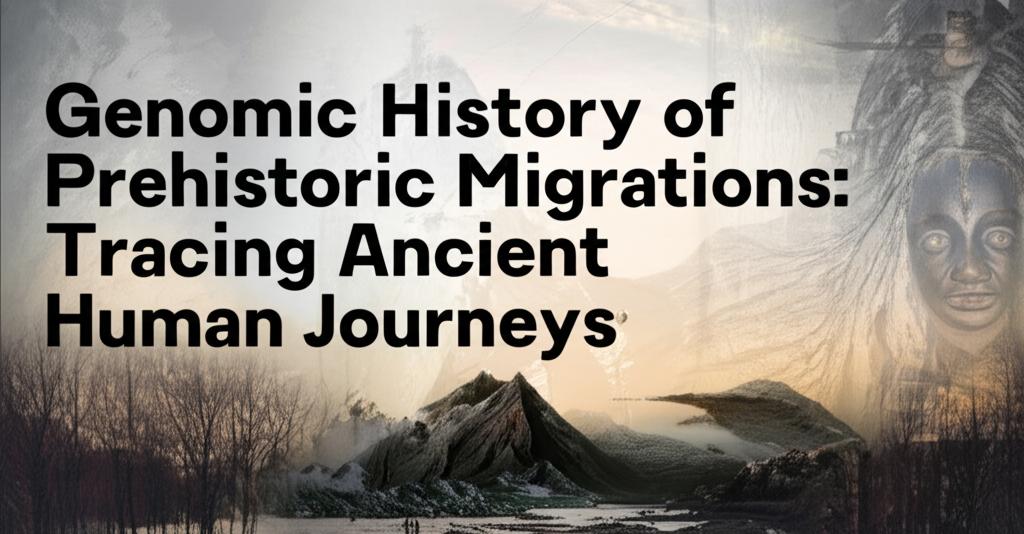Peering into the past through the lens of ancient DNA (aDNA) is like opening a time capsule, revealing the intricate sagas of our prehistoric ancestors and their epic journeys across the globe. Cutting-edge genomic research is dramatically reshaping our understanding of these ancient migrations, painting a vibrant and complex picture of human history that was previously invisible.
Unlocking Millennia of Movement: The Power of Ancient GenesScientists can now extract and analyze genetic material from human remains that are thousands, even tens of thousands, of years old. This incredible technology allows us to directly trace the genetic footprints of ancient populations, uncovering when and where they moved, who they met, and how they mixed. It’s a revolution in understanding our deep past, going far beyond what archaeology or the study of modern DNA alone could achieve.
The Americas: A Journey of Epic Proportions RevealedRecent groundbreaking studies have illuminated humanity's longest known prehistoric migration – a journey from North Asia, across the Bering Land Bridge (when ice sheets made such a route possible), and all the way to the southernmost tip of South America. This incredible trek, spanning over 20,000 kilometers, would have taken many generations thousands of years to complete. By comparing the genomes of modern individuals from indigenous groups in South America and Northeast Eurasia with ancient remains, scientists are mapping this astonishing expansion. These findings are not only rewriting migration history but also highlighting the incredible adaptability of early humans to vastly different environments. For instance, research indicates that modern humans reached northern Eurasia around 45,000 years ago and had migrated towards Beringia by about 31,600 years ago, eventually reaching the northwest tip of South America around 14,000 years ago.
Europe's Dynamic Past: Waves of Migration and TransformationEurope's genetic landscape is a tapestry woven from multiple major migration events. Ancient DNA has shown that the continent's prehistory was far from static.
- The Arrival of Farmers: Around 9,000 years ago, the Neolithic expansion brought early farming communities from the Near East into Europe. Genomic studies reveal that this wasn't just a spread of ideas; in many regions, it involved the movement of people who interbred with and, in some cases, largely replaced local hunter-gatherer populations. However, the picture is nuanced. In areas like the Baltic, hunter-gatherers seem to have adopted farming practices through cultural exchange rather than being overwhelmed by incoming farmers.
- Bronze Age Shake-up: The Bronze Age (roughly 3,300 to 1,200 BCE) witnessed further significant population shifts. Large-scale migrations, including those from the Steppe grasslands north of the Black Sea, dramatically reshaped the genetic makeup of Europe. Studies analyzing hundreds of ancient individuals have shown that people moving into southern Britain around 1300-800 BC contributed to about half the genetic ancestry of later populations. This wasn't necessarily a single, violent invasion but a result of sustained contacts over centuries, including trade, intermarriage, and smaller family group movements, likely from areas around present-day France. These migrations are also thought to be linked to the spread of Indo-European languages.
- First Millennium Migrations: Even into the first millennium AD, Europe remained a crucible of movement. Advanced DNA analysis techniques are now revealing finer-scale migrations during periods like the Iron Age, the fall of the Roman Empire, and the Viking Age. For example, evidence shows movements of Germanic-speaking groups southward from northern Europe, and later, Scandinavian ancestry appearing in Britain even before the traditionally recognized Viking Age.
Genomic research in Southeast Asia is uncovering a layered history of migrations. Studies have identified at least four major prehistoric migration waves. Early Hoabinhian hunter-gatherers show genetic links to the Onge hunter-gatherers of the Andaman Islands. Later, Neolithic farmers with distinct East Asian ancestry arrived, related to present-day Austroasiatic-speaking populations. Further migrations include the expansion of Austronesian speakers into Island Southeast Asia around 4,000 years ago and East Asians into northern Vietnam about 2,000 years ago. This "Two Layer" model and subsequent movements highlight the complex interplay of different groups in shaping the region's diverse genetic heritage.
Beyond Migration Routes: Insights into Ancient LivesAncient DNA doesn't just tell us where people went; it also offers glimpses into their lives.
- Social Structures: At sites like Çatalhöyük in Neolithic Anatolia, DNA from individuals buried within houses has helped reconstruct household structures, revealing that members were often linked through the female line, suggesting that male-centered practices weren't always dominant.
- Adaptation and Selection: By comparing ancient genomes, scientists can identify genetic adaptations that helped populations survive in new environments or combat diseases. For instance, studies on Neolithic European farmers show an overrepresentation of Mesolithic hunter-gatherer ancestry in the major histocompatibility complex (MHC), a key immunity locus. This suggests that these hunter-gatherer genes may have helped incoming farmers adapt to local pathogens.
- Disease History: Ancient DNA is even shedding light on the origins and spread of diseases. Research has mapped how risk genes for conditions like type 2 diabetes and multiple sclerosis were dispersed during large migration events thousands of years ago.
The field of ancient genomics is constantly advancing. New laboratory protocols, computational methods, and the increasing number of ancient genomes being sequenced are providing ever-finer resolution to our understanding of prehistoric human journeys. Each new discovery adds another piece to the colossal puzzle of how our ancestors populated the planet, overcame immense challenges, and laid the foundations for the diverse world we inhabit today. It's a testament to the resilience, adaptability, and enduring wanderlust of the human spirit.

